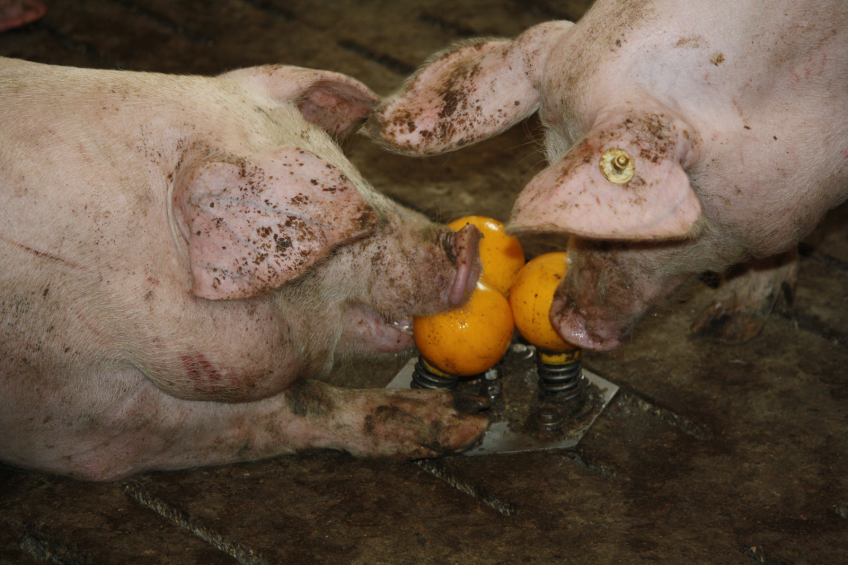Finisher pigs having a ball

Since January 2013, providing distraction materials to sows and pigs has become mandatory in the EU. A host of different solutions have been shown at trade shows, but funnily enough, pigs don’t seem too interested. What if a toy did capture their interest?
Why make a pig toy bright yellow? Researcher Nicola Jathe smiles. “Yellow is a colour the pigs will easily distinguish as it is not a colour that shows up in a farm regularly. In addition, red is not a colour pigs can see well… And besides – the first design was in yellow and we kept it like this.”
In the middle of the table is a yellow toy that has been in development for eight years at the University of Kassel in Germany – at the faculty of organic agriculture. Jathe says, “The idea of using balls actually stems from megastores like Ikea, where kids can play in a ball pit. One of my colleagues took this idea home and started to make prototypes.”
EU legislation on toys for pigs
Some attention for toys is very timely. After all, distraction material for pigs has become a bigger business in the European Union since the beginning of the year. In the wake of the EU sow housing legislation, European legislation also stipulates that each sow and gilt ought to have permanent access to rooting material – finisher pigs even should have permanent access to rooting and playing material. At recent trade shows, this led to an increase in the presence of all kinds of enrichment materials – like e.g. wooden elements, straw buckets and chains.
Finding a good toy, however, is easier said than done. Applying straw on a slatted floor may clog the manure system underneath, and others seem to be too predictable as pigs often lose their interest after a day or two, letting the wooden stick or chain hang uselessly in a corner of a pen. If the pigs haven’t already destroyed or swallowed their new gift, that is.
Since January 2013, providing distraction materials to sows and pigs has become mandatory in the European Union. A host of different solutions have been shown at trade shows, but funnily enough, pigs don’t seem too interested. What if a toy did capture their interest? Pig Progress visited a farm in Germany to find out…
Constructing a dynamic prototype of the yellow balls using springs, something remarkable happened, Dr Uwe Richter, University of Kassel, says – as the pigs continued to like it. “Even after several months, they still play with it – they even lie around it or sleep with their heads on top of it. We did not expect it was so good.”
The features probably explain the success, Richter says. The design, called ‘Wühlkegel’ in German – to be translated as ‘rooting cone’ – consists of three solid balls, placed in a triangular set-up. This way, the pigs can rub their snouts through them, giving them the feeling as if they are rooting, thus encouraging the animal’s natural behaviour.
Secondly, with a diameter of 80 mm, the polyurethane balls are just large enough for finishers to take them into their mouths, but they are too big for them to use their jaws with force. So to say – it’s an ideal pig size.
Thirdly, the life span of the rooting cone has been prolonged by reinforcing its basis with a black plastic element, reducing the rocking motion. Even in an environment with porcine owners, the toy is estimated to last for two years.
Richter says, “Over the years, many toys have been developed. They mainly just had to fit the federal EU laws and they were designed to look good through human eyes. They were not designed to fulfil the needs of pigs.”

Where in the pen to place the toys
The placement of the toy is remarkable – right in the middle of the pen, firmly attached onto the slatted floor by bolts – just covering 8 cm of one slat. This advice was given by Weda. The German company, well known for being a manufacturer of liquid feeding systems, was approached at EuroTier 2010 about the project and the company showed interest. It offered the researchers the opportunity to have the cone tested under practical, commercial conditions.
Ralf Meyer, head of development, Weda, explains: “One of our customers had long been using a completely different distraction device, in the middle of the pens. He noticed that he did not have a lot of tail biting with a toy right in the middle. As soon as he started using alternatives, e.g. toys on the side of the pen, tail biting returned.”
The reasoning sounds logical, assuming that most pigs prefer to be located against the walls for resting or feeding purposes – so there’s simply more room to play in the middle. Jathe says, “Now imagine a toy is in the corner, an interested pig may often see a ‘wall of pigs’ in front of him in order to reach it. If he cannot reach the toy, he may become aggressive, and chew on something else, for instance the tails of pigs standing in the way.”
Appreciating that tail biting is multifactorial, Meyer states that even if a reduction of tail biting of 5-10% could be proven, it would be impressive. Currently, Jathe is doing two scientific trials, aimed at detecting the cones’ influence on tail biting, on farms in the German states of Thuringia and Hesse. In a project at an 8,000 finisher farm, the pigs’ behaviour with and without cones is being monitored by video – and a lesion scoring scheme is being used to detect any skin lesions or wounds on the pigs’ skins. In addition, on a farm of 1,000 finishers, she hopes to discover more about the tail biting behaviour by direct observation. Influences on e.g. feed intake is a subject of further trials in the future.
Pig farm: Cones in a pig environment
Pig Progress visited a swine farm near Dinklage in Northern Germany to observe the cones in a pig environment. The Fangmann facility consists of 4 locations – 1 for breeding, 2 for finishing and 1 for combined growing and finishing. The location houses 4,500 growers and 3,000 finishers. The finishers are kept in pens of about 15 pigs.
As is common when entering any pig barn, the entering of people causes stress and restlessness amongst the animals. All those people wearing white suits were clearly worth a closer look. For the first minutes, all 3 month old finisher pigs lined up to see what this visit was all about. When the visitors turned out to be staring back at them with cameras in their hands, they returned to continue their daily routine.

First, 1 pig started sniffing at the cones. A second walked over them. A third started to lie down and rubbed its back against them. Then, while some pigs continued the staring and walking about, some others started lying down, nibble on the cones, rub their noses between the cones, or just lie close to them, around it, in some kind of a circle. In the corner, an ‘old-fashioned’ toy was hanging, but none of the animals touched that.
Farm owner Peter Fangmann, 41, who tests Weda products more often, has been using the cones in various finisher groups for several months now. He admits that the animals seem to be enjoying the cones and that he has not seen many occasions of tail biting in these groups. He adds, “Then again, tail biting in general is a weird phenomenon. It can occur irrespective of season and it can happen in one batch which has exactly the same feed as a next batch where nothing occurs. So who knows what we will see.”
A German patent (Gebrauchsmuster) was claimed for the rooting cone idea. Weda has taken up the task of manufacturing batches of rooting toys and at the moment about 500 to 600 are being tested on farms in Germany and beyond. The rooting cone was also proudly shown at EuroTier 2012. Official advice is to have one toy per 21 to 25 pigs – in case of larger pens.
Last but not least – what do producers think of it? After all, they need to be inside the pen as well to chase the pigs out at some point. Aren’t these objects in their way? Ralf Meyer smiles. “The producers can certainly see them – another good reason to make the rooting cones bright yellow! And even if they do stumble, after 2 times, they surely will remember.”
Distraction material for sows
Weda also developed a yellow ball for sows. This toy, consisting of two halves that can be screwed together, can be attached around the tubes of a free access stall or a farrowing crate. The diameter of these balls is slightly larger than the rooting cones – 90 mm, as a sow mouth is larger than one of a finisher pig. These balls are made from the same polyurethane material as the rooting cones. This ball has been rather popular, due to its simple set up and relative low cost price.












